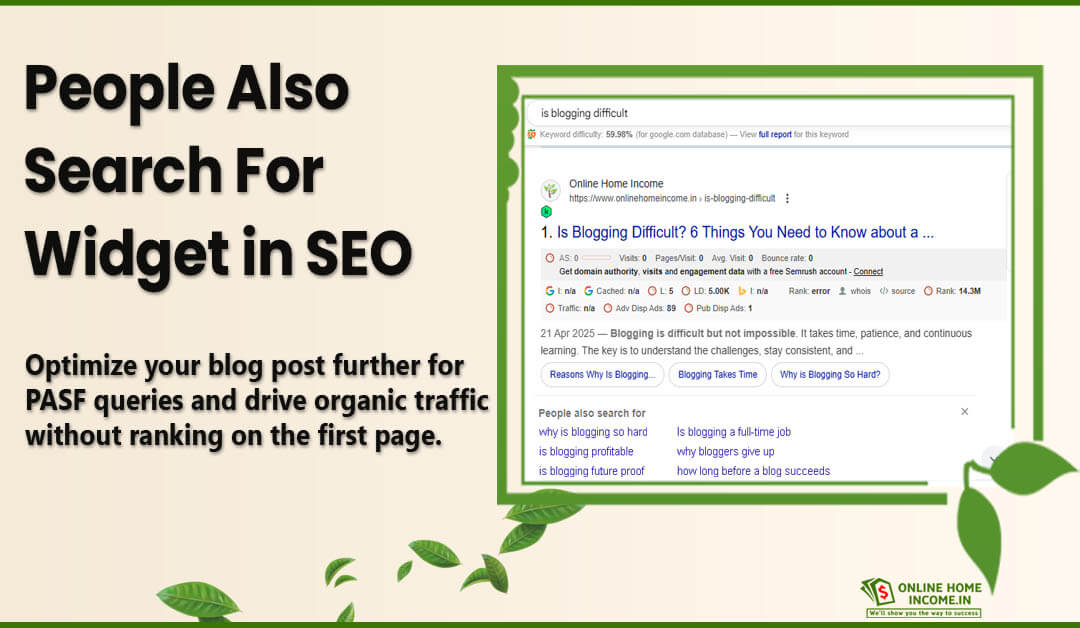If you want your blog to reach organic viewers, you must include long-tail keywords. Learn the advantages of long-tail keywords in getting higher conversions to your blog.
Out of all categories of keywords, long tail keywords are the most important to redirect users in dire need of results for their queries.
Such users query using more than 3-4 words, more like a direct question or sentence-like query. These specific queries constitute long-tail keywords.
When users find blogs addressing their dire needs on top search results, they will become regular followers and subscribers of the blogs.
So, it won’t be wrong to say that long tail keyphrases fetch your blogs the most organic traffic. Such users may be low in volume but contribute significantly towards your blog’s engagement.

I would recommend you read my previous article about, “What are long-tail keywords.” I would have also discussed how such keywords improve your blog’s Search Engine Optimization (SEO).
Moreover, I have also explained the steps to find and add such keywords in your blog posts.
In this post, I will explain the common benefits of long-tail keywords to bridge the gap between your blog and potential organic followers.
We will also learn how to target such keywords and find which would suit your blog best.
How to Find Long Tail Keywords with Low SEO Difficulty?
Creating long tail keywords involves three steps;
- Finding the user’s intent,
- Discovering low-traffic keywords from keyword research tools,
- Extracting long-tail keywords and creating blog posts that address them.
As a blogger, you must first understand why a user may want to come to your blog.
Their intent could be to gather information, find commercial recommendations, learn live information, or land on a page of their choice.
Users can come with one or more intentions and each intent may have relevant keywords. To know the keywords that yield good results, you must move on to your keyword research process.
I use Google Keyword Planner to find and prepare a keyword list before writing my blog posts. When it comes to long tail keywords, I ensure that such keywords have low SEO or Keyword Difficulty scores.
I leverage the ‘People Also Ask’ widget from Google search and SEMRush keyword research feature to discover long-tail keywords.
How to do?
When you search for “making ice cream” on Google, you might see questions like,
- How do I make ice cream without a machine?
- What are some easy ice cream recipes for beginners?
- Can I make vegan ice cream at home?
Pick the specific queries that match your blog niche and create a long-form blog post.
These key phrases have low SEO difficulty, and only the most organic search queries contain them.
So, use low-search volume and address specific user intent as quality filters for long-tail keywords.
Long Tail Keywords Examples
The biggest advantage of long-tail keywords is the many possibilities of keyword combinations one can generate.
More precisely, these keywords lead to specific topics that provide the exact solutions rather than beating around the bush.
Let us see some examples with the help of some keyword research tools.
CASE 1
| Keyword Type | Keyword | Search Volume |
| Focus KW | Start blogging | 1000+ |
| Secondary KW | How to start a blog | 750 – 1500 |
| LSI KW | Blogging tips | 700+ |
| Long-Tail KW | How to start a successful blog in 2024 | 150 – 600 |
CASE 2
| Keyword Type | Keyword | Search Volume |
| Focus KW | Make money blogging | 1000 – 10000 |
| Secondary KW | Ways to monetize my blog | 500+ |
| LSI KW | Blogging income | 100 – 500 |
| Long-Tail KW | Best ways to earn money from my blog | 400 – 1000 |
If you observe the above examples, you can infer that long-tail keywords appear more actionable.
Such keywords are directed at the user to help them implement whatever they have in mind. It could be starting a blog, earning money, doing a DIY hack, and anything else.
You may also observe that the traffic volume is lower than the focus keyword and secondary keywords.
7 Key Advantages of Long Tail Keywords in Blogging
Now, let us analyze the pros and cons of long-tail keywords. What may appear as a con is that we look for low-traffic volume suggestions.
However, this metric is a blessing in disguise to attract the most organic viewers to your blog.
Therefore, using a good dose of these keywords for each blog topic will slowly, yet correctly reach your target audience.
1. Enhanced Audience Targeting
The most common benefit of long-tail keywords is making your blog reach the right target audience.
For instance,
a user queries “coffee recipe with coffee maker.”
Possible high-traffic keywords for this query would include “coffee recipe,” “coffee maker coffee,” “easy coffee recipe,” etc.
Several peer blogs target such keywords, making top authorized blogs occupy the top search results.
Your blog will hardly find a space for this query if you target the above high-traffic keywords.
Consider keywords like these,
- How to make coffee with a coffee maker
- Easy coffee maker coffee recipe
- Coffee maker hacks for the best coffee
- Why must you invest in a coffee maker for your coffee today?
Targeting one or more of the above keywords in your blog post will soon make your blog appear on the top search results.
How could your blog replace several blogging giants?
When you target specific keywords that address a user’s concern, search engines prioritize your content first.
Remember that search engine crawlers do not just perform keyword matching but look for semantic relations of a blog with the user’s query.
Long tail keywords are the best bets to lure the audience exactly looking for the blog topic you cover.
2. Reduced Competition for Organic Traffic
Long tail keywords have a low search volume, making them keywords with low SEO difficulty.
When you start blogging (or are yet to establish yourself), you cannot expect your blog to appear on top search results.
Reaching the top spots of Search Engine Result Pages (SERPS) is the ultimate SEO goal of every blogger.
However, this process takes time, especially when a million other blogs compete for the same search query.
Here is where you can leverage the advantages of long-tail keywords.
By going for highly organic yet low search volume keywords, your blog has a high chance of getting listed on top results.
If your content is apt and suitable, you will win the competition.
Consistent organic views from long tail keywords improve your authority SEO score.
As a result, you will stand out in a crowded digital landscape by focusing on your niche topics for accurate user attraction.
A time will come when your niche becomes trending, and more and more users are interested in your blog topics.
At such times, long-tail keywords and their search volume increase.
Naturally, your blog fetches exponential views and converts most of your viewers to organic followers.
3. Increased Traffic and Conversions to Your Blog
Long tail keywords target highly specific results.
The resulting blogs that come on the top results of SERPs contain the exact information that users desire.
Such accurate results are possible because of Google’s AI-powered algorithms and SEO metrics.
Google’s search filters do not merely look for keyword matches. Its crawlers index matching pages and read the whole document to compute relevance, authority, and expertise scores.
Such filters ensure that the first result on search results is the most accurate and optimized result suitable for a user’s query.
95% of search queries get sorted in the first three search results.
Additionally, the users venturing to the blogs listed on top search results have a high potential to subscribe and become regular followers.
They may find more relevant and interesting content, which lures them and provides additional information.
For instance,
a user queries, “10 ways to get a vintage look for my house” and lands in a top blog.
The user also finds topics like “5 aesthetic must-have furniture for Victorian-style houses,” etc., in the same blog that match their interest.
Naturally, they will subscribe to more of your content and engage actively in your blog posts.
So, to convince search engines that your blog has the right content for user queries, you must cover related topics in the form of long-tail keywords.
4. Improved SEO Performance and Growth
For those unaware,
SEO refers to improving your blog’s visibility in several organic channels, like search engine result pages, social media search results, etc.
Every blogger strives to get increased visibility for their blogs by making them SEO-friendly.
Once they reach the top spots of SERPs, they must continue to prevent getting replaced by new or updated content from peer bloggers.
Top blogs in every blogging domain achieve this by continuously updating their content.
Google’s latest SEO metrics prioritize long-form and informative content that clearly addresses a user query.
Nearly 60% of organic search queries are composed of long-tail keywords.
When your blog is still in the nascent stages, targeting low-volume keywords is the best way to get visibility.
High-traffic keywords will fetch many high-authority peer blog pages in your domain for the top results on SERPs.
When you are covering low volume long tail keywords, that are not covered by most of your peers.
Hence, your blog gets a chance to feature on top SERPs right from when you publish it.
5. Long-Tail Keyword Research Techniques
One of the advantages of long-tail keywords is that they are easy to find.
Whenever you look for trending keywords in a domain, you will always get suggestions and recommendations for relevant keywords.
Such recommendations are the way to create new long-tail keywords or target existing low-volume keywords.
METHOD 01: Using “How to” Queries
For instance, if you Google a word in Google search, you will get a list of keyword suggestions in a drop-down box to complete your query.
Typing “How to,” will give you a list of trending inquiries in your region or areas of interest.
Adding one more word to this query, “How to blog,” will give you more specific suggestions on micro-niches and sub-topics.
Such suggestions give you a rich set of quality long-tail keywords for various keyword combinations.
METHOD 2: People Also Ask Widget
Google search results have a section called “People Also Ask.”
Suggestions in these also target long-tail keywords specific to trending or non-trending topics in your blogging domain.
Analyze the search traffic volume, engagement ratio, and domain relevance for such keyword sets. Then, find those with low traffic volume and high content potential.
You can use long tail keywords as your focus keyword and also make it part of your blog title.
Otherwise, you can include them as sub-topics and use them in sub-topic headers or within your content.
6. You can Become an Expert Blogger
Blogging, like any other profession, involves continuous learning in one’s domain. Every day, you need to discover endless possibilities for content creation in your niche and sub-niches.
The seed for discovering opportunities in blogging comes from user demands and intents.
When you get to know what users are searching for and how accurately they get results, you will understand the gap or void that you need to fill.
Researching for long tail keywords gives you a complete list of possible content topics for users’ requirements.
These topics lead to higher engagement and have a futuristic scope. Such topics also help you improve your knowledge in areas you may be unaware of.
The finer you address user demands, the better your expertise in your domain.
Long tail keywords give rise to endless possibilities from one keyword combination.
Blog posts relating to why, why not, how, how to, reasons, myths, and many more combinations from one long-tail keyword show your users that you have deep knowledge.
Consequently, your in-depth analysis and inferences on your blog posts fetch you more organic views.
These in turn improve your credibility and domain authority scores, which are crucial for your blog’s SEO.
7. Make Your Blog Relevant To Your Audience
A rule of thumb to make your blog rank higher is to make your content more relevant to search queries.
Generic and high search volume keywords contain a wide range of search results, which may not be relevant to what a user wants.
Long tail keywords address specific search queries that can provide ample potential for relevant blog topics.
In fact, such queries themselves qualify as high-potential blog titles.
Writing content relevant to addressing a user query will remain valuable, interesting, and long-lasting along with a particular trend.
But why can’t we cover everything related to a keyword in one blog post?
Why should it be relevant to one particular sub-topic?
Remember that before your viewers, search engines read through your blog’s content.
Unless your content is perfectly relevant to a search query, search engines discard them as low quality.
Content that is rich in information has an engaging tone and prompts readers to take action is given top priority for ranking.
So, when you plan your blog topic, ensure that your sub-topics address the problem at hand.
Plan the content skeleton along with the intent of the blog post, whether it is informational, transactional, commercial, or navigational.
Blog posts following this schema derived from long tail keywords are sure winners.
Best Practices for Utilizing Long-Tail Keywords
Now we know that long tail keywords are mandatory for every blog post for maximum visibility for organic traffic.
Let us see how to find and utilize them in our blog posts.
- Make sure your blog content exactly addresses the target long tail keyword.
- Use long-tail keyword generator tools like Google Search, People Also Ask, Keyword Planner, and SEMRUSH.
- Derive a content outline to create topics and sub-topic headers containing your long tail keywords.
- Write your blog post and remember to insert one or more long tail keywords in strategic locations like the Meta Title, Meta description, Blog Post Introduction, and Conclusion.
- Stuffing keywords can cause a negative SEO impact, so use them cautiously.
- Create blog topics using various combinations of the focus keyword to generate a new topic cluster that can attract a potential audience.
- Do not focus too much on search volume. Look at various parameters like engagement, content void, and domain relevance to find keywords that may have medium search traffic too.
Always stay relevant to your blogging niche and do not deviate by addressing out-of-the-box long-tail keywords.
Key Takeaways
There is no doubt that long-tail keywords can change the fate of your blog.
Targeting the right keyword and using it seamlessly convinces the search engines that your blog post is the perfect solution for a specific query.
As a result, your blog surpasses a million other blogs and websites to reach the top spot of search results.
Want to know something better that can happen?
If your blog post has the exact solution to a query, Google will rank your blog post as a “Featured Snippet” at the top over all other search results.
This feature is the highest mode of organic visibility for your blog.
Therefore, targeting long-tail keywords is crucial for higher SERP ranking and improving your blog strategy.
Furthermore, you can enhance visibility and higher conversion rates from organic traffic. Such parameters directly impact your monetization channels and earn you increased revenue.
For instance, if you blog about a concept and run a business in parallel, you can be assured that traffic coming to your blog with last-mile organic search queries will make a business with you.
Thorough keyword research and exploring potential domain opportunities yield high-quality long-tail keywords.
Conclusion
We learned how Google’s latest SEO metrics value blog posts that contain accurate information to solve a user query.
Additionally, the information should not be short and vague.
Lengthy and well-researched content about the topic is necessary to pass the search engine’s quality filters.
Long tail keywords are crucial for refined audience targeting, getting significant organic traffic, and converting them to regular followers of your blog posts.
Such keywords may have low search traffic, which is exactly why bloggers must target such content voids and provide informative content.
From this article, we learned the advantages of long-tail keywords and their impact on improving one’s blog SEO.
To learn how to write long-form and highly informational blog posts without deviating from a topic, look at my blog post on perfect blog post length.









